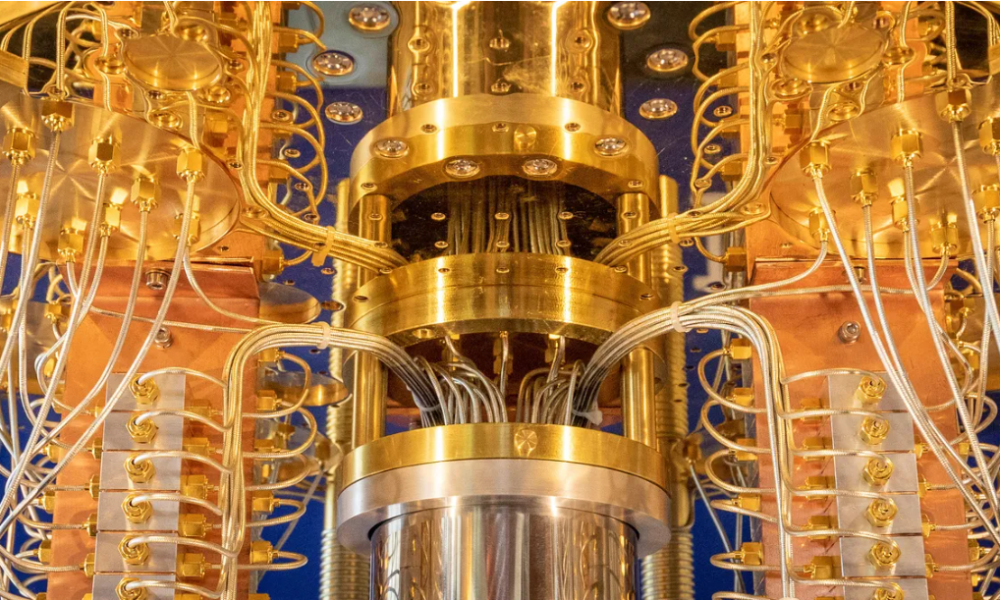Over the last decade, thanks to developments in hardware and software technologies, computers can now tackle problems previously thought impossible. Computer chips are faster (in accordance with Moore’s Law) and developing fields like deep learning—a class of algorithms that use brain-inspired neural networks to process data—allow computers to more efficiently organize and generate data, further propelling artificial intelligence forward.
Quantum technology is another developing field with revolutionary potential that has gained traction in recent years. The technology relies on quantum mechanics, which is a theory in physics that describes high-momentum objects on the smallest scales, like individual atoms and subatomic particles.
According to quantum mechanics, particles can exhibit random and counter-intuitive behaviours like superposition—the principle that a particle’s location is not actually a single location, but instead occupies several locations at once. But, as soon as the particle is observed, it randomly “chooses” one of those locations via a process called decoherence. It’s like Shrödinger’s cat. We only know the cat is dead once we open the box—until then, anything is possible.
Besides location, particles have other properties that exhibit this same behaviour, like momentum and spin. As long as the particle is not directly observed, these precarious quantum behaviours are present.
Quantum computing is one exciting application of this principle. By confining and isolating particles, scientists and engineers try to leverage quantum behaviours to create computers that process information differently than your laptop would. While a classical computer uses bits—digits of 0 or 1—to encode information, a quantum computer uses qubits—digits that can be in a superposition of both 0 and 1 by harnessing particles with quantum properties. This affords extra flexibility when doing certain arithmetic computations, theoretically allowing quantum computers to exponentially outperform classical computers.
“If we want to build such a computer, it has some minimal requirements,” says Bill Coish, an associate physics professor at McGill who researches physical systems that are applied in quantum computers. “That we can prepare quantum states arbitrarily in this physical system, that we can evolve them in time in a way that preserves quantum information, and that we can measure them in the end.”
Currently, scientists can construct quantum computers that meet these requirements, but not at the scales necessary to perform useful computing tasks.
“If you want to do something practical, current estimates suggest that you probably need millions of these qubits. And you need them to operate extremely well,” Coish said. “People have demonstrated qubits that operate extremely well for up to a few hundred [qubits in a quantum computer].”
Due to the instability of quantum particles, handling quantum states without disrupting the information they contain is a major challenge to building practical quantum computers. In an attempt to circumvent this issue, physicists and computer engineers are trying to integrate an error correction protocol into quantum computers.
Error correction is the process of mitigating the unwanted decoherence of delicate quantum states that hold information. The particles used to make qubits are prone to unwanted interactions with their environments that collapse the quantum superpositions that make them special. Often, error correction requires adding extra qubits to the quantum computer to create redundant backups of data so that if one quantum state collapses, its information is not lost.
“When you want to introduce a quantum error correction protocol, you need redundancy, and that’s why people estimate you need millions of quantum bits,” Coish explained.
Many algorithms for quantum computers have already been designed and are now awaiting machines to run on. If scientists can successfully construct quantum computers that contain millions of qubits, they could accomplish tasks that would irrevocably change many of the technologies we depend on.
A working quantum computer could produce more powerful simulations of chemical and physical systems, which would support the development of robust, sustainable materials and medicines. It would also provide much faster solutions to optimization problems used in machine learning and solve the impossible-by-design puzzles that are the backbone of current cybersecurity systems. If we woke up tomorrow with fully-fledged quantum computers, there could be an economic catastrophe within days.
Luckily, the timeline of quantum computing is thought to be slow enough to give us a chance to prepare for these problems before they arise.
“It will be 20 to 50 years, I believe, before we have a full-scale quantum computer. But for us cryptographers, it’s good news,” said Claude Crépeau, a McGill computer science professor and quantum cryptographer, in an interview with The Tribune.
As quantum technologies change the landscape of cryptography, quantum cryptographers look to implement new security protocols in a timely manner.
“From this point on, it’s going to be the industry’s responsibility to change their systems,” Crépeau said. “The budgets to get these changes done are being voted on and governments push [the] industry to do these things. I think this change will happen.”
Outside of pure quantum computing, there is an active scene of quantum technology that could see great advancements in the next couple of years, including light sensors and novel communication methods.
McGill assistant physics professor Kai Wang, who researches meta-optic materials that manipulate light and harness its quantum properties, is optimistic about the development of these technologies.
“No matter if the goal [of building quantum computers] gets achieved, I think there could be many other things related to this goal that also get developed,” Wang said.
Wang hopes that by applying quantum physics principles, light sensors with lower margins of error and less error overall could be developed. One possible application of such sensors is in lidar technology.
“Lidar is like the light version of radar. There’s an interest in developing this technology for automatic driving,” Wang said. “It scans the 3D environment, then light gets scattered back and there’s some sensor collecting the information.”
Crépeau’s field of quantum cryptography is another rapidly developing area. He researches how quantum effects send information more secretly and securely than classical cryptographic methods, leveraging the same decoherence that haunts quantum computing to provide information on whether a message has been tapped.
Though slower than classical communication, these methods have already been used to stream video from a Chinese satellite back to Earth.
Another developing area is noisy intermediate-scale quantum systems (NISQ). NISQ systems use classical computers and small, noise-prone quantum computers we currently have in tandem to solve optimization problems or perform difficult mathematical computations.
“These problems might be really interesting in the next year or two years. It’s not some far, future, abstract idea,” Coish said. “The best way forward in that area, in my opinion, is to have some really good intuition about what problems you should try, and just go and run them.”
The private sector plays a significant role in these developments, but contact between academics and private industry is an important part of driving the field forward.
“Everyone who works [in the private sphere] comes at some point from academia [….] They started their lives as scientists where they would publish their information as much as possible, and so I think they still have that attitude,” Coish said.
The private quantum space is more collaborative than other technology industries, where trade secrets are more confidential. For Wang, the backgrounds of quantum computer developers have made a difference in the developments achieved in the field.
“I do see a lot of emerging startup companies and people trying to push quantum computing into real-world applications,” Wang said. “This is probably one of the biggest changes that I have observed, but on the other hand, the research community is working closely with the industrial partners.”
As more companies enter the space to tackle specific applications of quantum science, we must prepare for rapid development in the next few years, with frontrunners like IBM and Google working towards building large quantum computers in the long term.








